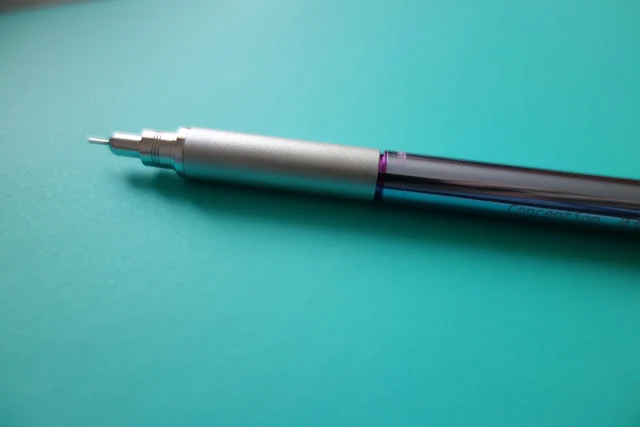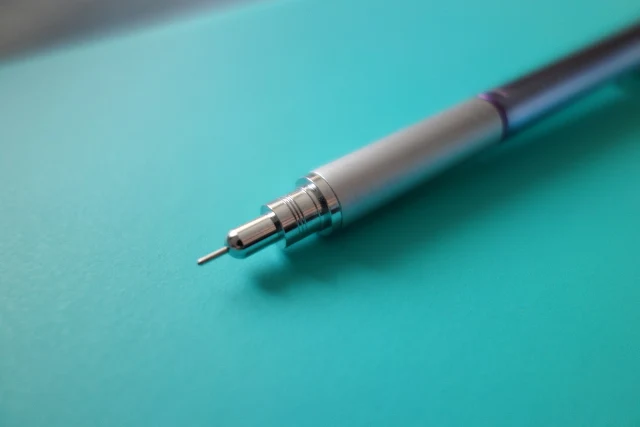Thursday, December 27, 2018
Review of the Ohto Conception mechanical pencil
Excuses aside I want to review the Conception mechanical pencil which I have mentioned about in a previous post. Tanks to Matthias from Bleistift blog, Dave from Dave's mechanical pencils and
Brad from The Pen Addict.
This pencil was reviewed by Mathias from Bleistift.com some time ago, so please check his post and the youtube video.
I have seen them at that time but can’t remember the conclusion so this will be my view on the mechanical pencil. It will be interesting to see after, how each views the same product.
First of all the color, which I find it to be very nice. It could be seen as a bit feminine, but I think it works for everyone. It is an all metal body, with the barrel a light pale purple, a midsection with a darker violet. The grip is a mat finish gray that has a bit of tactile feel to it and it has enough grip. The rest of the pencil: tip, clip, and pusher are glossy gray.
The pencil has very subtle markings, OTO and Conception along with lead size, that is written in a color that is close to the barrel color and in a small font. It gives the pencil a clean look and technical feel.
This pencil has 2 very interesting features that make it a bit unique. The first thing that you notice are 4 holes in the side of the barrel that show you how much the lead advances. Yes, you can control it. So if you ever felt the traditional mechanical pencil doesn’t got this right you can opt for the Conception. At the maximum setting, the lead will advance 15 mm after 10 clicks and the minimum setting will offer 4 mm of lead for 10 clicks. A huge difference, and of course you can set it any ware between this 2 values.
The second unique feature of this mechanical pencil is the fact you can have a fixed sleeve or a retractable sleeve. By screwing the barrel to the grip you make it a fixed sleeve, that is very good for technical work, and precision lines. While for general writing you might prefer to have a sliding sleeve, so you will click the advance mechanism a lot fewer times. This makes the pencil pocket safe because the sleeve slides all the way in.
The clip and the eraser are good and I do not have complaints about them. One thing that is reminiscent of older pencils is a pointy tip imbedded in the eraser for unclogging the pencil. Rotring has dropped this after the first generation of Tikky, so I do know how to feel about it. Is the pencil not reliable enough and the manufacturer knows you will get into trouble? or is it there just to give you comfort and ease of mind in case something goes wrong? Take it the way you want, I am a bit skeptical.
One thing I have not talked about is the lead size. The pencil in my possession is a 0.3 m lead. It is the first one for me.
I don’t know how to feel about it at this moment, as I have not used it enough. Lately, I am incline to use 0.7 mm more often than the 0.5. I think this is because I rarely need the pencil to do detailed work and mostly I use it for notes. Engineer or not computers are used for the real work stuff while paper and pencils are mostly used to put down some thoughts, ideas and notes.
The fine point is a very different experience even compared to the 0.5 mm, and it offers a lot of control and precision. In the end this lead size to me seams to be a more specialized thing, making it less practical. I mean it is very good for detailed work and taking small notes in a limited space, for example, a book, but will not be very good for writing as you will frequently need to click the advance mechanism. Having a fine point makes it more fragile and having a sliding sleeve will make your lead break fewer times or not at all.
So in my opinion the purpose of the sliding sleeve in this pencil is more for protection, and not for long writing sessions.
The pencil offers a very nice feel in hand, for me is a great fit. One thing that I would change is the transition from the barrel to the grip section. It should have been better grinded to make a smoother transition.
One other thing I would like to mention is the screwing mechanism that makes the sleeve fixed or slide and the click of the lead advance. You can feel the spring that offers resistance and it is not smooth or quiet. It is not too bad, but I feel there is room for improvement.
Thursday, December 6, 2018
10 $ or less
Here are a few ideas
For the South Park fans, here are some Cartman quotes on the side of pencils
You can buy them here
If you enjoy the good attitude and hard-working spirit of Sponge Bob you can go for the eraser set, that includes figurines of Mr. Krabs and Patrick as well.
Eraser set
And where better to put the pencils and erasers you just purchased, if not in a gross fish like pencil case. I guess you could keep it between real fish for a few days just to offer the realistic feel, smell wise. It also looks really spacy
Fish pencil case
Saturday, November 24, 2018
What lead size to use for general writing

I will start with, science is hard, or at least my pseudoscience is. I will test how the most common lead size perform:
0.5 / 0.7 / 0.9 or 1.0
0.9 and 1.0 is the same size, but different producers refer to it differently. From now on, I will refer to both sizes as 1.0
I guess you already have the answer to my question. Which ever lead size you like the most is the best, and I probably say 0.7 is the most usual lead of them all. But I am going further with my quest. So prepare ...
The so-called test
I wanted to see how much lead is used for the same amount of writing using each of the lead sizes mentioned above.
This is hard work, and I do not think I will be doing science anytime soon after all this experimenting.
I used Rotring HB leads with the aforementioned sizes 0.5; 0.7; 1.0. Other brands might offer different results because of the lead hardness "... 2B B HB H 2H ..." is not standardized. So HB from other suppliers might be softer or harder.
I started the test by writing 1-page size A4 (254x297 mm). To be as consistent as humanly possible, I used "math" paper and wrote in every single cell of the paper with very little pressure, and the same letter height, the letters of the alphabet over and over again. I preferred this method instead of freehand, so the results will be as scientific as correct as they can get.
This is not representative of real world writing, but it doesn't have to be. The important part of the test is comparing the leads to each other and see what are the differences.
After I wrote a few pages with each of the leads that are participating in the writing test, I measured the length of the remaining lead.
The results
In theory, I could have written with a single lead, size 0.5 mm, - 30 pages, but I have to take into account that when the lead becomes too small you have to throw it away, so more realistic I would say 27 pages.
Of course, this depends a lot on how small or big do you write, how condensed, how much pressure etc. So don't focus on this figure, as it is not the important one. The difference between the test results says the story.
The 0.7 mm can write in theory 60 pages and the 1.0 mm over 120 pages. This means that the writing you are able to do with 1 lead doubles every time you bump up the lead size.
Because I could not measure the lead used up on a single page with size 1.0 (under half of mm) I cranked up the pace and applied extra pressure and made a bunch of lines and X.
So after the endurance test the 0.5 mm lost 3.5 mm; the 0.7 mm lost 1.5 mm, and the 1.0 lost 0.5 mm from its total length
It does not seem a lot but assuming I could use the entire lead, 60 mm, the 1.0 size I could do as much writing as with 3 pieces of 0.7 mm lead or 7 pieces of 0.5 lead.
Similarly, if you would take the 0.7 mm as a benchmark, then I would need 2.33 pieces of 0.5 mm lead to do the same amount of writing.
Conclusion
You should choose the thicker lead, especially if you have a heavier hand, for three reasons.
1) The first reason is the price. The price of lead is usually the same for all thicknesses.
You will pay 3 times more if you use 0.7 lead instead of 1.0
You will pay 7 times more if you use 0.5 lead instead of 1.0
You will pay 2.33 times more if you use 0.5 lead instead of 0.7
2) The second reason is the advancing of the lead. The less lead you use, fewer clicks you will have to make. So in a long writing session, a thicker lead is bliss.
3) And third, the risk of breaking the lead is smaller with thicker lead.
Ok, you may ask, "Won't the line be too thick if I use 1.0 mm?"
It will, but not by a lot. There is a small difference between the 0.7 mm and the 1.0 mm lead. The downside is that you have to rotate the pen in your hand more often when you use 1.0 mm lead.
 |
| 1.0 mm vs 0.5 mm lead |
 |
| 1.0 mm vs 0.7 mm lead |
Thursday, October 11, 2018
A Rolex and a Montegrappa
Maybe Rolex Rainbow is not the most conspicuous watch to wear, but I think it will go really well with the Montegrappa Rainbow. Assorting your watch with the fountain pen could be a new trend.
Follow the link to see the post with the first watch - fountain pen combo, a match made in heaven between Kaweco sport and Nomos.
Popular Posts
-
This is the best and most fun game you can play, and you have to try it now. Why? Because it's hilarious, fast-paced, everyone in the...
-
I am a long Rotring Tikky user and today I will share with you the beloved mechanical pencil. I got my first Rotring mechanical penci...
-
Jinhao made me very curious with one of its latest fountain pen in the lineup. I had to have the pen just because of its nib. It is a bit un...
-
Rotring has moved away from fountain pens over the years. The only fountain pen model that is still available is the Rotring Artpen, whic...
-
The fountain pen ink is produced by Koh-I-Noor in the Czech Republic. It comes in a plastic bottle, 50 g (or roughly 50 ml) like in the pi...














